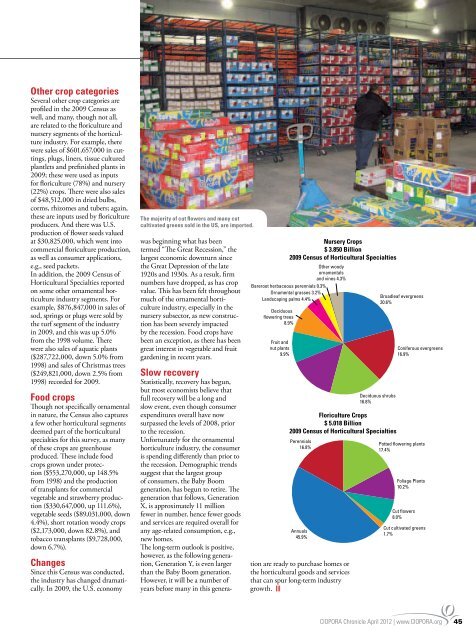2012 CIOPORA Chronicle
CIOPORA annual magazine on Intellectual Property protection for plant innovations 2012. The magazine was produced in cooperation with FloraCulture International. Read in the 2012 CIOPORA Chronicle edition: - Plant Patents in the United States after the America Invents Act - U.S. plant patents compared to UPOV PBR system - Does Belgian patent law need a breeder’s exemption? - How much open access can breeders afford? - IPP and PBR in Chile - IP protection for plant innovations in Canada and much more...
CIOPORA annual magazine on Intellectual Property protection for plant innovations 2012. The magazine was produced in cooperation with FloraCulture International.
Read in the 2012 CIOPORA Chronicle edition:
- Plant Patents in the United States after the America Invents Act
- U.S. plant patents compared to UPOV PBR system
- Does Belgian patent law need a breeder’s exemption?
- How much open access can breeders afford?
- IPP and PBR in Chile
- IP protection for plant innovations in Canada
and much more...
Create successful ePaper yourself
Turn your PDF publications into a flip-book with our unique Google optimized e-Paper software.
Other crop categories<br />
Several other crop categories are<br />
profiled in the 2009 Census as<br />
well, and many, though not all,<br />
are related to the floriculture and<br />
nursery segments of the horticulture<br />
industry. For example, there<br />
were sales of $601,657,000 in cuttings,<br />
plugs, liners, tissue cultured<br />
plantlets and prefinished plants in<br />
2009; these were used as inputs<br />
for floriculture (78%) and nursery<br />
(22%) crops. There were also sales<br />
of $48,512,000 in dried bulbs,<br />
corms, rhizomes and tubers; again,<br />
these are inputs used by floriculture<br />
producers. And there was U.S.<br />
production of flower seeds valued<br />
at $30,825,000, which went into<br />
commercial floriculture production,<br />
as well as consumer applications,<br />
e.g., seed packets.<br />
In addition, the 2009 Census of<br />
Horticultural Specialties reported<br />
on some other ornamental horticulture<br />
industry segments. For<br />
example, $876,847,000 in sales of<br />
sod, springs or plugs were sold by<br />
the turf segment of the industry<br />
in 2009, and this was up 5.0%<br />
from the 1998 volume. There<br />
were also sales of aquatic plants<br />
($287,722,000, down 5.0% from<br />
1998) and sales of Christmas trees<br />
($249,821,000, down 2.5% from<br />
1998) recorded for 2009.<br />
Food crops<br />
Though not specifically ornamental<br />
in nature, the Census also captures<br />
a few other horticultural segments<br />
deemed part of the horticultural<br />
specialties for this survey, as many<br />
of these crops are greenhouse<br />
produced. These include food<br />
crops grown under protection<br />
($553,270,000, up 148.5%<br />
from 1998) and the production<br />
of transplants for commercial<br />
vegetable and strawberry production<br />
($330,647,000, up 111.6%),<br />
vegetable seeds ($89,031,000, down<br />
4.4%), short rotation woody crops<br />
($2,173,000, down 82.8%), and<br />
tobacco transplants ($9,728,000,<br />
down 6.7%).<br />
Changes<br />
Since this Census was conducted,<br />
the industry has changed dramatically.<br />
In 2009, the U.S. economy<br />
The majority of cut flowers and many cut<br />
cultivated greens sold in the US, are imported.<br />
was beginning what has been<br />
termed “The Great Recession,” the<br />
largest economic downturn since<br />
the Great Depression of the late<br />
1920s and 1930s. As a result, firm<br />
numbers have dropped, as has crop<br />
value. This has been felt throughout<br />
much of the ornamental horticulture<br />
industry, especially in the<br />
nursery subsector, as new construction<br />
has been severely impacted<br />
by the recession. Food crops have<br />
been an exception, as there has been<br />
great interest in vegetable and fruit<br />
gardening in recent years.<br />
Slow recovery<br />
Statistically, recovery has begun,<br />
but most economists believe that<br />
full recovery will be a long and<br />
slow event, even though consumer<br />
expenditures overall have now<br />
surpassed the levels of 2008, prior<br />
to the recession.<br />
Unfortunately for the ornamental<br />
horticulture industry, the consumer<br />
is spending differently than prior to<br />
the recession. Demographic trends<br />
suggest that the largest group<br />
of consumers, the Baby Boom<br />
generation, has begun to retire. The<br />
generation that follows, Generation<br />
X, is approximately 11 million<br />
fewer in number, hence fewer goods<br />
and services are required overall for<br />
any age-related consumption, e.g.,<br />
new homes.<br />
The long-term outlook is positive,<br />
however, as the following generation,<br />
Generation Y, is even larger<br />
than the Baby Boom generation.<br />
However, it will be a number of<br />
years before many in this genera-<br />
Deciduous<br />
flowering trees<br />
8.9%<br />
Fruit and<br />
nut plants<br />
9.9%<br />
Nursery Crops<br />
$ 3.850 Billion<br />
2009 Census of Horticultural Specialties<br />
Other woody<br />
ornamentals<br />
and vines 4.3%<br />
Bareroot herbaceous perennials 0.3%<br />
Ornamental grasses 3.2%<br />
Landscaping palms 4.4%<br />
Perennials<br />
16.8%<br />
Deciduous shrubs<br />
16.8%<br />
Floriculture Crops<br />
$ 5.018 Billion<br />
2009 Census of Horticultural Specialties<br />
Annuals<br />
45.9%<br />
tion are ready to purchase homes or<br />
the horticultural goods and services<br />
that can spur long-term industry<br />
growth. |||<br />
Broadleaf evergreens<br />
20.6%<br />
Coniferous evergreens<br />
16.9%<br />
Potted flowering plants<br />
17.4%<br />
Foliage Plants<br />
10.2%<br />
Cut flowers<br />
8.0%<br />
Cut cultivated greens<br />
1.7%<br />
<strong>CIOPORA</strong> <strong>Chronicle</strong> April <strong>2012</strong> | www.<strong>CIOPORA</strong>.org 45









